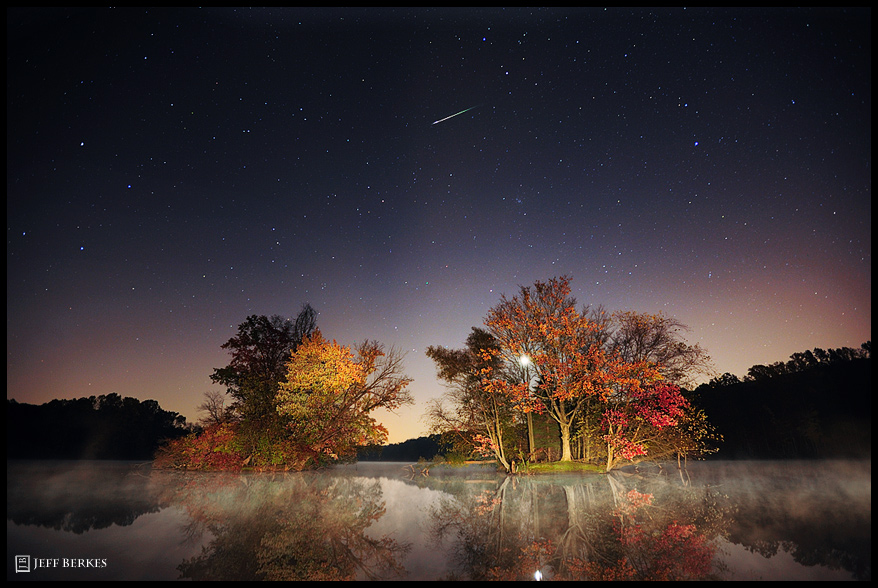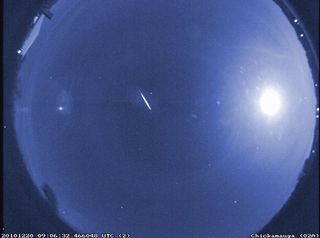
Update: See our latest observing guide and preview for the weekend Orionid meteor shower here: Orionid Meteor Shower Peaks Tonight: How to Watch Online
A meteor shower spawned by history’s most famous comet will peak this weekend, and the show could be dazzling for observers with clear skies, experts say.
The Orionid meteor shower will reach its zenith overnight from Saturday to Sunday (Oct. 20-21) as Earth plows through debris shed by Halley’s Comet on its path around the sun. The most impressive display should come a few hours before dawn Sunday, when our planet hits the densest patch of Halley’s detritus.
"Flakes of comet dust hitting the atmosphere should give us dozens of meteors per hour," Bill Cooke, head of the Meteoroid Environment Office at NASA’s Space Flight Center in Huntsville, Ala., said in a statement.
The moon will be just five days removed from its new phase on Saturday night, and it won’t show up in the pre-dawn skies early Sunday. So bright moonlight shouldn’t drown out many streaking meteors this weekend, researchers said.
The Orionids — so named because they appear to originate near Betelgeuse, the second-brightest star in the constellation Orion (The Hunter) — have historically produced about 20 meteors per hour during their peak. However, the shower has been especially impressive in the last half-decade or so, Cooke said.
"Since 2006, the Orionids have been one of the best showers of the year, with counts of 60 or more meteors per hour," he said.
Get the Space.com Newsletter
Breaking space news, the latest updates on rocket launches, skywatching events and more!
Skywatchers who want to learn more about the Orionids and how to observe them this weekend can join Cooke and his team in a live web chat overnight Saturday, from 11:00 p.m. to 3:00 a.m. EDT (0300 to 0700 GMT Sunday). Go to this web page at the appointed time to participate.
The Orionids are one of two annual meteor showers produced by icy pieces of Halley’s Comet. The other shower, called the Eta Aquarids, peaks each year in early May.

Halley’s Comet returns to the inner solar system every 75 or 76 years, and it's bright enough to be seen by the naked eye. The comet’s last appearance in our skies came in 1986, and the next is due in 2061.
In 1705, English astronomer Edmond Halley suggested that a comet spotted 1682 was the same one that lit up the sky in both 1531 and 1607. He further predicted it would be back in 1758. When this last appearance did in fact come to pass, the comet was given Halley’s name.
Editor's Note: If you snapped any photos of the Orionid meteor shower and want to share them with SPACE.com, send the pictures, comments and location info to managing editor Tariq Malik at tmalik@space.com.
Follow SPACE.com senior writer Mike Wall on Twitter @michaeldwall or SPACE.com @Spacedotcom. We're also on Facebook and Google+.
Join our Space Forums to keep talking space on the latest missions, night sky and more! And if you have a news tip, correction or comment, let us know at: community@space.com.

Michael Wall is a Senior Space Writer with Space.com and joined the team in 2010. He primarily covers exoplanets, spaceflight and military space, but has been known to dabble in the space art beat. His book about the search for alien life, "Out There," was published on Nov. 13, 2018. Before becoming a science writer, Michael worked as a herpetologist and wildlife biologist. He has a Ph.D. in evolutionary biology from the University of Sydney, Australia, a bachelor's degree from the University of Arizona, and a graduate certificate in science writing from the University of California, Santa Cruz. To find out what his latest project is, you can follow Michael on Twitter.